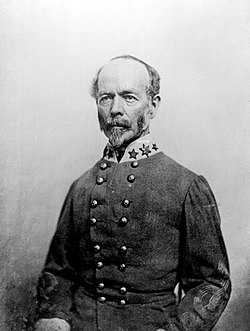 |
| The Positions of the armies on July 18th. |
This morning, General Johnston joined Beauregard's army along the Bull Run. He had been ordered to leave the Shenandoah Valley and his opponents there behind, and bring his army to unite with Beauregard to crush McDowell. He was able to do this by moving quickly on the railroads, and because of the inattentiveness of his opponent, Patterson.
 |
| Gen. Joseph E. Johnston |
Johnston was a full general, and Beauregard was only a brigadier, so Johnston took command of the army. But since Beauregard was familiar with the situation, he let him make many of the important decisions, while still retaining a hand in the direction of the events. Johnston approved a plan to attack McDowell on the Union left the next morning. Orders were sent out to alert the commanders of what they needed to do. However, the complicated plan was not relayed well. The orders were unclear, and many were not delivered at all. The next day would show the extent to which the Confederate army was ready to make the attack.
 |
| Gen. Irvin McDowell |
While Johnston and Beauregard were preparing their plans, McDowell was ordering an attack as well. Through the noise of trains coming into the Confederate camp, he guessed correctly that Johnston had arrived with the army of the Shenandoah. He did not wish to try again on the Confederate right at Blackburn's Ford, where Tyler had been repulsed a few days before. Instead, he chose to attack on the Confederate left. So both armies planned to attack the other’s left the next morning. It was apparent that the next day could bring the battle that would decide the course of the war.





0 comments:
Post a Comment